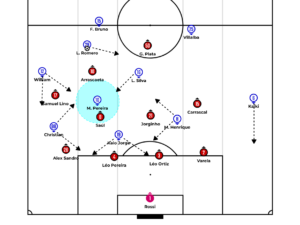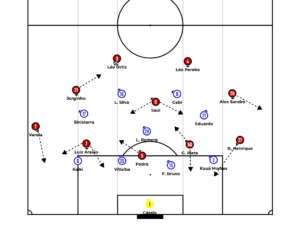Flamengo – Cruzeiro: A timid clash for the top of the Brasileirão (0-0)
Flamengo and Cruzeiro, two teams battling at the top of the Brasileirão table, faced off on Matchday 26 but stood out more for their defensive organization and how they prevented goals than for playing attractive football. Still, the coach of the league leaders praised the match, saying it had the “intensity of European football.” How positive is that, really?
Tactical analysis and match report by Marcus Arboés.
Filipe Luis has been adopting starting lineups that often spark controversy. At times, a player in great form is left out for the sake of the game plan. With a deep squad full of options, those choices become easier. Flamengo therefore kept most of its starting base: Rossi in goal; Varela on the right, Alex Sandro (former Juventus) on the left, Léo Ortiz and Pereira as center-backs; Jorginho (former Arsenal) and Saúl (former Atleti) as holding midfielders; up front, Samuel Lino on the left wing, Carrascal and Arrascaeta inside, and Gonzalo Plata playing as the number nine. In practice, they attacked in a 3-2-5 shape.
Cruzeiro, the visitors, managed to field an almost ideal lineup in a 4-2-3-1 outline. The experienced Cássio was in goal, with William at right fullback, Fabrício Bruno (Brazil National Team) and Villalba as center-backs, and the young Kaiki on the left; Lucas Romero and Lucas Silva (former Real Madrid) formed the double pivot, with Matheus Pereira as the number ten. Up front, Kaio Jorge (former Juventus) led the line, while Christian and Matheus Henrique (former Sassuolo) played as narrow attacking midfielders rather than natural wingers.
Two strong teams, neutralized ideas
Filipe Luis was right when he said something about this match in his post-game interview: it looked like a European-style game in terms of intensity. Both teams pressed well after losing the ball, defended aggressively, and neutralized each other’s strengths. Still, it had “little of Brazil” — few unpredictable or magical moments. No goals were scored, and that makes a game of this magnitude a bit poorer from a spectacle standpoint.
This happened mainly because of both teams’ defensive efficiency at different heights. Flamengo managed to nullify Cruzeiro’s quick and mobile attacks, while Leonardo Jardim’s side neutralized Flamengo’s long-ball and possession-circulation strategies.

Cruzeiro’s buildup play overloaded the flanks, using a mobile square in midfield with the fullback advancing and the first holding midfielder dropping close to the center-backs, against Flamengo’s pressing in a 4-1-3-2 formation.
With the ball, Cruzeiro actually played the more interesting game. They were lighter in buildup, and their vertical progressions came through mobility and freedom of movement among their five midfielders, creating width and looking for a fullback or Kaio Jorge making runs in behind.
During buildup, Lucas Romero dropped between the center-backs, while Christian and Lucas Silva provided passing lanes behind Flamengo’s first pressing line. Higher up, Matheus Pereira and Matheus Henrique positioned themselves behind Flamengo’s second line, forming a square that shifted toward the ball side. The depth options were always Kaio Jorge, pinning the last line, and the advancing fullback (William or Kaiki) overlapping on the outside.
To deal with Cruzeiro’s quick vertical passing — a relational positional approach that creates confusion — Flamengo pressed high in their usual 4-1-3-2 shape. Up front, Gonzalo Plata and Arrascaeta alternated between pressing the ball-carrying center-back and marking Lucas Romero inside. Behind them, Carrascal, Saúl, and Lino closed man-to-man on the fullback and two midfielders on that side, while Jorginho protected the space behind, alongside the fullback (Varela or Alex Sandro). Léo Ortiz and Léo Pereira were responsible for tracking Kaio Jorge’s runs.
Even with fewer players committed forward, Flamengo’s compact defensive density on the flanks made it difficult for Cruzeiro to settle in the attacking half. Jardim’s team managed to reach the final third a few times through quick transitions, but without much danger.

Cruzeiro’s offensive organization in a functional 4-2-3-1 asymmetric shape, against Flamengo’s zonal defense in a 4-4-2 formation.
That improved toward the end of the first half and early in the second, when Cruzeiro created the best chances of the goalless draw. Pushing into the attacking half, Lucas Romero and Lucas Silva operated at different heights — the latter advancing more through central spaces, while Romero acted as the main distributor.
Matheus Henrique and Matheus Pereira orchestrated play with positional freedom, while right midfielder Christian supported combinations or attacked spaces created by Kaio Jorge. One fullback provided support on the ball side, while the other became the switch option.
Because Flamengo closed central spaces so effectively, neutralizing Cruzeiro’s short associative play and winning most duels physically, the best route was through switches of play. Romero played a crucial role there, with Matheus Pereira dropping deeper like a holding midfielder to help unlock attacks. Cruzeiro’s best move came from a long diagonal by Lucas Romero to Kaiki attacking the far-side corridor.

Flamengo’s positional attack in a 3-2-5 shape with Jorginho dropping on the right to attempt long balls, mainly toward Gonzalo Plata, against Cruzeiro’s organized 4-4-2 outline pressing by sector without losing compactness.
Flamengo, on the other hand, didn’t face as much pressing from Cruzeiro during buildup — something other opponents have tried, sometimes with partial success against Filipe Luis’s tactics. Cruzeiro preferred to wait and strike through fast transitions, exploiting open space.
Jorginho was central to Flamengo’s attacking efforts. Instead of staying central or tucking a fullback between the center-backs, in this variation he acted as an offensive right center-back, receiving freely to attempt long passes toward the front five: Plata, Lino, Varela, Arrascaeta, and Carrascal.
The idea was to exploit the space left by Kaiki’s individual marking on Carrascal, with Plata running from inside to outside. But Fabrício Bruno was tasked with covering Villalba’s back, and he had a strong defensive performance.
On the left, Alex Sandro tucked inside as an auxiliary midfielder so Samuel Lino could receive in advantage on the left wing — but he often found himself isolated, delayed by William, while Christian dropped to double up on him. Lino, Flamengo’s best dribbler, was constantly pushed away from the last line and double-marked when he reached it.
What stopped the goals in the second half?
Filipe Luis and Leonardo Jardim made no changes at halftime, but the game developed with Cruzeiro waiting deeper, prioritizing quick counterattacks, while Flamengo focused on wide attacks and crosses instead of direct vertical play.
Flamengo had two early chances before Filipe Luis brought on Bruno Henrique on the left to add aerial threat. Abandoning the midfield battle, since Cruzeiro was compact, he replaced Arrascaeta and Carrascal with Luiz Araújo and Pedro, adding more off-ball movement and crossing options. However, the substitutions didn’t change much, as Flamengo barely managed to produce dangerous crosses.

Cruzeiro defending with one man down
Late in the game, William received a second yellow for a harsh foul on Bruno Henrique, forcing Cruzeiro to reorganize. They switched to a 4-1-4 shape, with Lucas Romero shielding the central area, Eduardo and Sinisterra wide doubling up on the wingers, and Lucas Silva alongside Gabigol (former Flamengo) protecting the central zones without pressing high.
Even with one man down, Cruzeiro’s compactness forced Flamengo wide. Their crossing plan didn’t work, largely due to the excellent performances of Cruzeiro’s center-backs. In the closing minutes, it turned into a classic positional-play-versus-defense scenario, with Flamengo having sterile possession.
Takeaways
High intensity, physical duels, and strong tactical discipline from both sides — two teams that effectively canceled each other out. From a tactical and strategic perspective, it was an interesting match to study. But for the fan or the passionate football lover, it lacked the excitement expected from a top clash.
Filipe Luis praised the “European intensity” of the match, but what matters most is that Flamengo stayed four points ahead of Cruzeiro with one game in hand in the title race. Still, the draw brought Palmeiras closer — just three points behind with a game in hand over the Rio de Janeiro side. Next up, Flamengo faces Bahia on Sunday.
Cruzeiro will also face a northeastern opponent that day: Sport, who drew heroically against Fluminense in stoppage time this round. The bottom-placed team could make life difficult for Cruzeiro, who will be without Kaio Jorge and William, both suspended.
Use the arrows to scroll through all available match plots. Click to enlarge. Check the match plots page for plots of other matches.




Comments